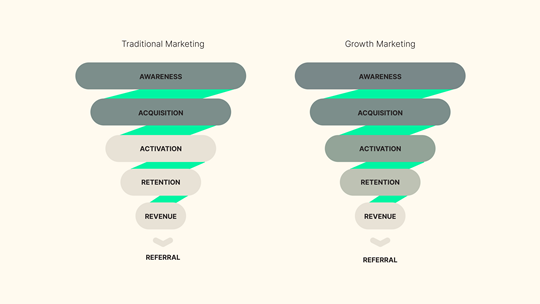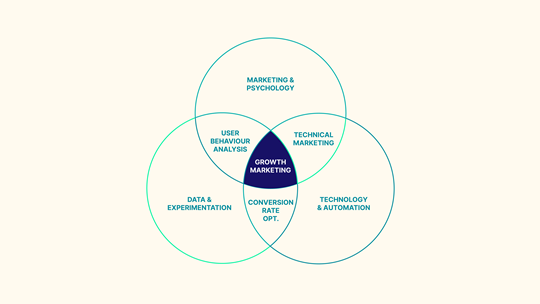What is growth marketing?
Does your brand and business analyse every element of your marketing strategy from the initial purchasing of media space up to re-engaging with those who have purchased previously? Do you have your digital spend in one place and manage it in a completely agnostic way. Are your marketing and customer experience efforts completely aligned with the ongoing development and evolution of your digital ecosystem? If so then you are already growth marketing and if not then read on.
Growth marketing teams are not solely focused on feeding users or people into the top of the funnel. This is the focus of traditional marketing.
By being data-driven, growth marketers are able to be adaptable and find new innovative methods to not only maximise user volume at a reduced cost, but also looking at how to increase conversions, drive positive interactions, build repeat purchase, advocacy and recommendations.
Just remember, sustainable growth isn't defined by the volume of new users coming through the door, it's about retention.
The Difference Between Growth Marketing And Traditional Marketing
Traditional marketing regularly looks to convert leads into paying customers as soon as possible. Growth marketing however, will carry a user through the funnel with the objective of building that individual to becoming an advocate of the brand. Understanding the customer and treating them as a person, instead of a number on a sales sheet.
The approach of overseeing the full funnel from one strategy benefits not just the brand and business, but also the end customer and user. Making the right decisions at the right time allows for a win-win scenario for both parties, allowing for the business to obtain a sale and repeat sale, whilst the user receives a complete product built just for them.

What Growth Marketing Strategies Should You Implement Today?
It’s clear that there isn't a one size fits all approach, but there are certain elements to any growth strategy which you should consistently put in place.
Be Innovative
Research, trial and implement new marketing methods. Whether this be a new platform, new CRM system, changes in product packaging, product promotion or general pricing. Don’t just challenge your competition, challenge your own brand.
Build Social Proof
Free communication is free advertising. Ensuring a follow up is received by happy customers will increase the chances of building the volume of positive reviews and testimonials. Having customers who are loyal will lead to them ultimately becoming brand ambassadors, who can make or break a sale or long term relationship with a customer.
Constant Communication
Users and potential customers won't flow naturally through the funnel without appropriate guidance. Be in constant communication, but ensure your comms are also adapting to the right phase of the funnel. Repeating the same message is a sure way to put a sale on hold or push a user over to the competition.
Be Creative
There is never just one tactic, message or visual that will always work. Play to your brand’s strengths and nuances. Even the biggest brands in the world cycle through different creative.
Data-driven Campaigns
Be sure to analyse your data consistently. Identify what channels your customers are coming from, how are they engaging on your platform, why did they decide to leave, what chosen conversion path did they follow and how do they respond to certain email campaigns? Don’t leave anything to guess work, make your decisions on justified, physical data from real customer behaviour.
Constant iteration of the digital platform
By leading with marketing, customer data and customer experience it is equally important to constantly iterate and adapt the entire digital ecosystem. By adding new features, testing new user interactions and building strong conversion paths, graphics and interface elements to enhance the users needs you can leverage an increase in spend, maintain retention and outsmart your competitors. The two must work hand in hand to deliver the best result.

So What Does A Growth Marketer Need To Have?
A growth marketer has many skills and is usually capable of building a marketing strategy which encapsulates the right mixture of channels to create a winning formula.
This can range from anything from conversion rate optimisation (CRO) practices to building email marketing automations and optimising social media campaigns to analysing customer data.
Throughout a campaign or partnership, metrics need to be prioritsed alongside business KPIs that physically represent genuine growth. These are represented by the following:
- Lead generation metrics
- Conversion and purchase metrics
- Customer retention metrics
- Average customer lifetime value metrics
Which Brands Have Incorporated Growth Marketing Strategies?
The first and most obvious success story is Harry’s Razors. Since the early 2010’s, Harry’s has been growing at a 300% rate faster than any of its competitors (Rakuten Intelligence 2019).
Their success stemmed from innovating and building a subscription based model providing customers with loyalty schemes. Not only by being one of the first razor blade businesses to take on this model, but Harry's got much of their growth marketing strategy right. From having quality products to a focused target audience to disruptive pricing.
Etsy is another brand which over the years has seen long-term growth and consistent growth. Their strategy was solely about building brand advocacy from within its customer base. Since 2012 Etsy has grown from generating $70m a year generating business to $800m a year in 2019 (Statista 2019).
The business was able to define a niche within the market with a disruptive pricing angle (under-cutting eBay) and by leveraging their organic social channels. Their customer experience is one to also be admired, which again has been a powerful tool in increasing the average lifetime value of each of its dedicated customers.
Growth Marketing At cab engine
For years the teams at Cab Engine has worked towards their own philosophy and framework known as “The LIFEcycle”. This framework represents an ecosystem about challenges and not channels. Identifying the key problems with a business and building a growth marketing strategy, which provides sustainable growth.
So what does the LIFEcycle entail? It’s about challenges - not channels, which are easier to connect and be creative with when you pose these 4 questions.
- How do customers Locate you when they are looking for you?
- How do you Inspire customers to want your product or service?
- How do you Focus your online traffic to maximum purchase and goals with a positive experience?
- How do you Engage your customers to become repeat purchasers and brand ambassadors?
By following this framework, Cab Engine can identify opportunities for again marketing - not being content with just a singular purchase. Instead, strategies will be put in place to ensure a lasting impression is made on the purchaser, to the point your brand remains front of mind and the chance of a brand recommendation or repeat purchase is highly likely.
How To Move Forward With A Growth Marketing Strategy?
Over the past 18 years Cab Engine has helped many businesses all over the world adapt to a more sustainable and long-term growth strategy. If you want to know how Cab Engine and its team of growth experts can help you and your brand, get in touch today and our team will be in touch to begin driving growth.
